Book contents
- Frontmatter
- Contents
- Preface
- I Agents in the World: What Are Agents and How Can They Be Built?
- II Representing and Reasoning
- 3 States and Searching
- 4 Features and Constraints
- 5 Propositions and Inference
- 6 Reasoning Under Uncertainty
- III Learning and Planning
- IV Reasoning About Individuals and Relations
- V The Big Picture
- A Mathematical Preliminaries and Notation
- Bibliography
- Index
4 - Features and Constraints
from II - Representing and Reasoning
- Frontmatter
- Contents
- Preface
- I Agents in the World: What Are Agents and How Can They Be Built?
- II Representing and Reasoning
- 3 States and Searching
- 4 Features and Constraints
- 5 Propositions and Inference
- 6 Reasoning Under Uncertainty
- III Learning and Planning
- IV Reasoning About Individuals and Relations
- V The Big Picture
- A Mathematical Preliminaries and Notation
- Bibliography
- Index
Summary
Every task involves constraint,
Solve the thing without complaint;
There are magic links and chains
Forged to loose our rigid brains.
Structures, strictures, though they bind,
Strangely liberate the mind.
–James FalenInstead of reasoning explicitly in terms of states, it is often better to describe states in terms of features and then to reason in terms of these features. Often these features are not independent and there are hard constraints that specify legal combinations of assignments of values to variables. As Falen's elegant poem emphasizes, the mind discovers and exploits constraints to solve tasks. Common examples occur in planning and scheduling, where an agent must assign a time for each action that must be carried out; typically, there are constraints on when actions can be carried out and constraints specifying that the actions must actually achieve a goal. There are also often preferences over values that can be specified in terms of soft constraints. This chapter shows how to generate assignments that satisfy a set of hard constraints and how to optimize a collection of soft constraints.
Features and States
For any practical problem, an agent cannot reason in terms of states; there are simply too many of them. Moreover, most problems do not come with an explicit list of states; the states are typically described implicitly in terms of features.
Information
- Type
- Chapter
- Information
- Artificial IntelligenceFoundations of Computational Agents, pp. 111 - 156Publisher: Cambridge University PressPrint publication year: 2010
